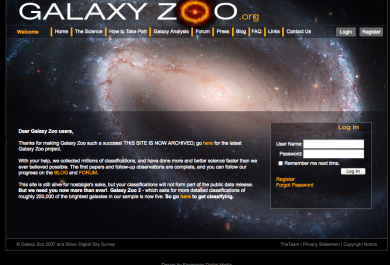Who?
Chris Lintott and Kevin Schawinski are the founders of the project; they initiated the dissemination actions that addressed the general public, as a target audience.
What & How?
The Galaxy Zoo website is the primary source of dissemination of the project activities. It includes a blog and a forum that support the volunteers in the discussion, analysis and classification of galaxies. Other dissemination activities are videos available on You Tube, releases and news articles in important journals and TV (Times Online, USA today, Spiegel online, BBC news, etc.). The main dissemination contents are images, video, text and data.
The dissemination project outputs are both galaxy images associated with the Sloan Digital Sky Survey (SDSS), available on the ad hoc developed Galaxy Zoo website, and the results presented in scientific articles and open-source sets of the analysed data.
When?
Dissemination activities started in an early stage of the project with the aim to share the project objectives and involve of a large number of volunteers in the analysis of images. During the data collection and analysis process, SDSS images were available on the website along with their classification provided by citizen scientists supported also through Galaxy Zoo Blog and Talk. Also teaching materials were shared to support teachers and educators. In the last phase, the results of analysis are presented in scientific articles and gathered in open access datasets. Relation to Open Science
The rights of the published scientific results, images and videos are held by NASA. The FreeFlyer simulation software is proprietary commercial software, whereas the NASA’s Eyes software is developed by the California Institute of Technology, so they hold the rights. For scientific articles published by Nature or Elsevier, the rights are managed by the corresponding publisher.
Scientific data gathered during the mission that are publicly available can be used by researchers for further investigations. Scientific articles underwent a classical peer review process. Available alternative metrics are: the number of newspaper headlines, number of views of YouTube videos, number of tweets or number of downloads of the simulation software.
It can, therefore, be concluded that NASA followed the paradigm of a rather closed research activity.
Relation to Open Science
Galaxy Zoo is released under a Creative Commons license, but the design and graphical elements of the site, including the logo, are separately copyrighted. Also, galaxy images are governed by the SDSS copyright policy. Project results are open to a large number of potential contributors. Raw data can be used for novel knowledge production. All data related to the project and scientific publications are available in specific sections on the project website. Data are also retrievable through links in the published papers.
The majority of scientific articles are submitted to arXiv, one of the best-known preprint open archive that is based on a moderator system in charge of reclassification and/or removals of the submitted article. arXiv has download metrics on the entire archive.
Effort
Galaxy Zoo involves a lot of professionals and uses high-quality tools. The website was created by a web design company. The Galaxy Zoo Blog and Talk are moderated by specialists. The galaxy images come from the Sloan Digital Sky Survey and are high quality.
The website was developed by an external service; costs can be estimated as low-medium, ranging from EUR 5,000 to EUR 50,000.
Impact
Followed by news and social media as well as research institutions, Galaxy Zoo has had a great success and has reached a large audience. Concerning scientific impact, the project played an important role in new knowledge and scientific advancement. The experiment was successful so that the original Galaxy Zoo project, which ran from July 2007 until February 2009, was replaced by Galaxy Zoo 2, Galaxy Zoo: Hubble, and Galaxy Zoo: CANDELS.
Gender
There are no specific initiatives targeted to women. The project is developed by two men who are engaged in every phase of project dissemination. The working team is composed of more men than women. According to an online survey (Raddick et al. 2010) on volunteers’ motivations for participating to Galaxy Zoo, male volunteers (80%) are more represented than female volunteers.
Highlight
|
||
|---|---|---|
|
ZooTeach is a website where teachers and educators can share high-quality lesson plans and resources that complement all Zooniverse citizen science projects. Lessons can be retrieved by age groups and subject areas that also comprise the topics related to Galaxy Zoo. |
||
Link
For a more extensive analysis of the Galaxy Zoo case study, please follow the link: http://openup-h2020.eu/wp-content/uploads/2017/01/OpenUP_D4.1_Practices-evaluation-and-mapping.-Methods-tools-and-user-needs.pdf





